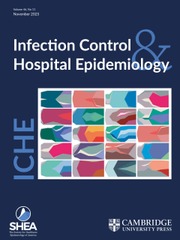To the Editor—We read with great interest the recent article by Scheuerman et alReference Scheuerman, Schechner and Carmeli 1 showing that extended-spectrum β-lactamase (ESBL)-producing Escherichia coli (ESBL-EC) and Klebsiella pneumoniae (ESBL-KP) bloodstream infections (BSIs) differ significantly in terms of mortality (33.7% vs 17.4%; P=.016). Because their study concerns a highly relevant and popular topic, some points should be discussed.
First, ESBL-KP–infected patients were more often hospitalized in ICU than those infected by ESBL-EC (P<.001), partly due to a septic shock, which may explain such a high rate of mortality (33.7%) for a bloodstream infection (BSI). Indeed, the observed mortality rate for ESBL-KP was similar to the average mortality for those with gram-negative BSIs in the ICU (35%) according to the prospective EUROBACT International cohort study.Reference Tabah, Koulenti and Laupland 2 Also, ICU-acquired BSIs are associated with a 40% increase in the risk of 30-day mortality.Reference Adrie, Garrouste-Orgeas and Ibn Essaied 3 Therefore, it is hard to believe that such a difference could be accounted for in any statistical adjustment, and thus, it constitutes a selection bias.
Second, the main source of BSI was urinary tract in the ESBL-EC arm (P=.005), while it is acknowledged that the severity of urinary tract infection is not related to the presence of bacteremia.Reference Artero, Esparcia, Eiros, Madrazo, Alberola and Nogueira 4 Such data underly the hypothesis that ESBL-KP infections might have been more severe than those due to ESBL-EC. For instance, multidrug-resistant BSIs complicating respiratory tract infections have been associated with an increased mortality (odds ratio [OR], 3.26; 95% confidence interval [CI], 1.29–8.22).Reference Saliba, Saadeh and Bouchand 7
Third, no information is provided about the respective antimicrobial regimens between ESBL-EC and ESBL-KP patients. However, it is currently argued that carbapenem alternatives are associated with a higher mortality rate than carbapanems for the treatment of ESBL BSI. In fact, the MERINO trial by Harris et alReference Harris, Peleg and Iredell 5 was recently suspended due to an increase in mortality in the arm receiving piperacillin-tazobactam (12.3%) versus meropenem (3.7%).Reference Harris, Peleg and Iredell 5 Such data should have been discussed. Likewise, no information is provided on treatment duration or dose, which may have varied between the 2 groups in the present study.Reference Scheuerman, Schechner and Carmeli 1 Both factors play a role in the outcome of treatment, especially when used against multidrug-resistant organisms.Reference Davido, Bouchand and Dinh 6
Interestingly, we previously showed that BSI severity or mortality among spinal cord injury patients over 15 years was not related to the multidrug-resistant characteristics of the microorganism.Reference Saliba, Saadeh and Bouchand 7 Although our sample size was small (n<30), a closer look at the outcome between ESBL-EC (n=26) and ESBL-KP (n=13) did not reveal any statistical difference in terms of mortality rate (7.7% in each arm). Moreover, the mortality rates were similar for other ESBL microorganisms (Enterobacter spp, Morganella spp, and Proteus spp (n=21)), ~9.5% (P=.99, data not shown).
In fact, we believe that the findings of Scheuerman et al, which showed no impact of CTX-M isolates in comparison to other ESBL genotypes, might support the idea that the type of germ does not play a major role. Indeed, mortality seems more related to patient comorbidities and severity of infection, as shown in Table 2 of the article,Reference Scheuerman, Schechner and Carmeli 1 with significant discrepancies between the 2 groups in terms of length of stay to bacteremia (P=.017), source of infection (P=.005), ICU ward admission (P<.001) and underlying cardiovascular disease (P<.001). Moreover, in a rabbit model of sepsis induced by a multidrug-resistant Klebsiella pneumoniae, Zhou et alReference Zhou, Ren, Liu, Gu and Li 8 showed that mortality was higher for the rabbits infected by susceptible than those infected with multidrug-resistant strains.
Overall, the impact of ESBL-KP isolates on mortality rate might have been overestimated, in the light of the severity of the patient condition.
Acknowledgments
Financial support
No financial support was provided relevant to this article.
Potential conflicts of interest
All authors report no conflicts of interest relevant to this article.


